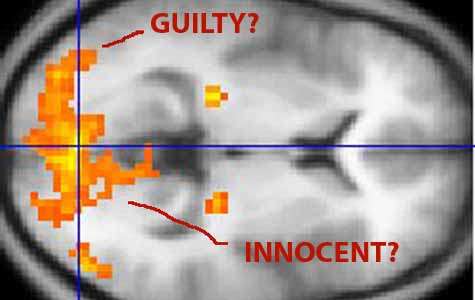March 26, 2013 report
Predicting repeat offenders with brain scans: You be the judge

(Medical Xpress)—Despite the well known inaccuracies of polygraph lie detectors, they remain in widespread, if selective, use by the criminal justice system. While they are far from truth machines, if the person who is interviewed believes that they have caught in a lie, the prosecutorial sector can turn the thumbscrews so to speak. Predicting future arrest, however, is not something a polygraph can address—if the parolee doesn't even know if he or she might re-offend, how can a yes/no classifier? A study published yesterday in PNAS is the latest in a series of efforts to use fMRI to assign risk to the possibility of repeat offense. They do not claim to have found the repeat offense area of the brain, but rather determine this risk by proxy, namely a measure of impulsivity.
To measure impulsivity, the researchers focused on the anterior cingulate cortex (ACC), a region that when lesioned by stroke, or in animal studies has been associated with an increase in inappropriate behaviors. The test was to press a button when a common stimulus was presented, and refrain from pressing the button when a rare cue was presented. The researchers were able to show that those (N=96) who had reduced ACC activity, as inferred from the MRI signal, were associated with double the risk of repeat offense within four years of their release.
One of the concerns here is that, as we have seen, the MRI is far from quantitative. Right there in the abstract on this paper, the authors directly associate a relatively low ACC activity with an approximately double rearrest rate. For many, matching an adjective to a number, at least for measures of brain activity, is still a tough sell. Part of the problem here is that the ACC cannot be cast only as region of impulse control. We have just seen a study where DBS (deep brain stimulation) electrodes have been placed in the ACC to treat anorexia. This follows on the heels of other studies putting limbic system electrodes (in the associated fornix) to improve memory in Alzheimer's, which was a side effect of having the electrodes in there to treat, of all things, obesity.
One implication of these observations is that, however far-fetched it may sound today, having a DBS unit in your ACC would have to absolve you from repeat offender status. Even if you turned the device off, you could argue that your ACC activity was depressed only because it had been acclimatized to the constant stimulation. Looking at images of the actual electrode placement for the anorexia study shows that they were in a part of the ACC called the subcallosal anterior cingulate. This is at least a centimeter or so below the region used in the rearrest study, but still continuous with it in form and function. One thing that has not escaped us here, is that the "control" area used for the fMRI is exactly this subcallosal cingulate area. Furthermore the subcallosal cingulate, at least to the accuracy of the MRI image is not just a cortical region, but an interconnection nexus where white matter tracts criss-cross in age old neural phylogeny which varies considerably across individuals.
We mention these comparisons only to show some of difficulties involved with making these kinds of interpretations Fortunately, or unfortunately depending on your position, brain scans are rapidly improving. The video here of the zebrafish mentating upon the tastier points of a nearby paramecium tells nothing of its impulse or intention to eat it—at least yet. This kind of detail would be quite invasive to reproduce in humans. Spying on ones inner thoughts is however less invasive than some of the other efforts to assign risk to repeat offenders.
Penile plethysmography is a very real technology which can assign a number to potential child abusers. It can be argued that it only gives an indicator of perception or attention as opposed to actual intent to do something. When considering what little else parole officers have to go on to asses risk, it is clear that these kinds of studies, however flawed, have a very real value. The temptation to use them in a proactive prosecutorial fashion should, as we have seen, be highly cautioned against.
More information: Eyal Aharoni, Gina M. Vincent, Carla L. Harenski, Vince D. Calhoun, Walter Sinnott-Armstrong, Michael S. Gazzaniga, Kent A. Kiehl, Neuroprediction of future rearrest, PNAS, 2013. Wil be available at www.pnas.org/cgi/doi/10.1073/pnas.1219302110
Abstract
Identification of factors that predict recurrent antisocial behavior is integral to the social sciences, criminal justice procedures, and the effective treatment of high-risk individuals. Here we show that error-related brain activity elicited during performance of an inhibitory task prospectively predicted subsequent rearrest among adult offenders within 4 y of release (N = 96). The odds that an offender with relatively low anterior cingulate activity would be rearrested were approximately double that of an offender with high activity in this region, holding constant other observed risk factors. These results suggest a potential neurocognitive biomarker for persistent antisocial behavior.
Via NatureNews
© 2013 Medical Xpress














